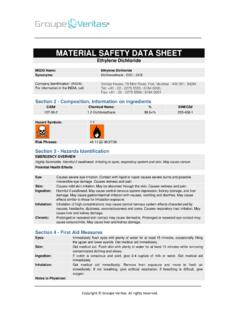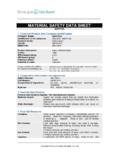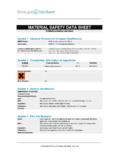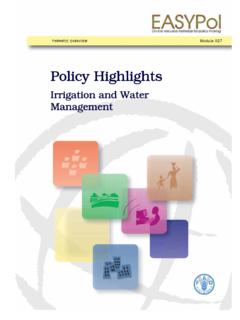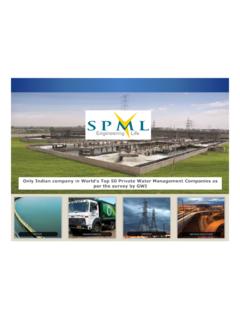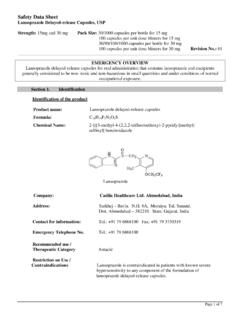Transcription of MATERIAL SAFETY DATA SHEET - Petrochemicals / …
1 Copyright Groupe Veritas. All rights reserved. MATERIAL SAFETY data SHEET Isopropanol Section 1 - Chemical Product and Company Identification MSDS Name: Isopropanol Synonyms: Isopropyl alcohol; 2-Propanol; IPA Company Identification: (INDIA) Veritas House, 70 Mint Road, Fort, Mumbai - 400 001. INDIA For information in the INDIA, call: Tel: +91 - 22 - 2275 5555 / 6184 0000, Fax: +91 - 22 - 2275 5556 / 6184 0001 Section 2 - Composition, Information on IngredientsCAS# Chemical Name: % EINECS# 67-63-0 Isopropanol 99 200-661-7 Hazard Symbols: XI F Risk Phrases: 11 36 67 Section 3 - Hazards IdentificationEMERGENCY OVERVIEW Highly flammable. Irritating to eyes. Vapours may cause drowsiness and dizziness.
2 Potential Health Effects Eye: Produces irritation, characterized by a burning sensation, redness, tearing, inflammation, and possible corneal injury. Skin: Prolonged and/or repeated contact may cause defatting of the skin and dermatitis. May be absorbed through the skin. Isopropanol has a low potential to cause allergic skin reactions; however, rare cases of allergic contact dermatitis have been reported. Ingestion: Causes gastrointestinal irritation with nausea, vomiting and diarrhea. May cause kidney damage. May cause central nervous system depression, characterized by excitement, followed by headache, dizziness, drowsiness, and nausea. Advanced stages may cause collapse, unconsciousness, coma and possible death due to respiratory failure.
3 Inhalation: Inhalation of high concentrations may cause central nervous system effects characterized by nausea, headache, dizziness, unconsciousness and coma. May cause respiratory tract irritation. May cause narcotic effects in high concentration. Vapors may cause dizziness or suffocation. Chronic: Prolonged or repeated skin contact may cause defatting and dermatitis. Section 4 - First Aid MeasuresEyes: Immediately flush eyes with plenty of water for at least 15 minutes, occasionally lifting the upper and lower eyelids. Get medical aid immediately. Skin: Get medical aid. Flush skin with plenty of water for at least 15 minutes while removing contaminated clothing and shoes. Ingestion: Do not induce vomiting.
4 If victim is conscious and alert, give 2-4 cupfuls of milk or water. Never give anything by mouth to an unconscious person. Get medical aid immediately. Copyright Groupe Veritas. All rights reserved. Inhalation: Get medical aid immediately. Remove from exposure and move to fresh air immediately. If not breathing, give artificial respiration. If breathing is difficult, give oxygen. Notes to Physician: Urine acetone test may be helpful in diagnosis. Treat symptomatically and supportively. Section 5 - Fire Fighting MeasuresGeneral Information: As in any fire, wear a self-contained breathing apparatus in pressure-demand, MSHA/NIOSH (approved or equivalent), and full protective gear.
5 Vapors may form an explosive mixture with air. Vapors can travel to a source of ignition and flash back. Will burn if involved in a fire. Containers may explode in the heat of a fire. Flammable liquid and vapor. Vapors may be heavier than air. They can spread along the ground and collect in low or confined areas. Extinguishing Media: Use water spray to cool fire-exposed containers. Use foam, dry chemical, or carbon dioxide. Use flooding quantities of water as spray. Section 6 - Accidental Release MeasuresGeneral Information: Use proper personal protective equipment as indicated in Section 8. Spills/Leaks: Absorb spill with inert MATERIAL ( vermiculite, sand or earth), then place in suitable container.
6 Remove all sources of ignition. Use a spark-proof tool. Provide ventilation. A vapor suppressing foam may be used to reduce vapors. Section 7 - Handling and StorageHandling: Wash thoroughly after handling. Ground and bond containers when transferring MATERIAL . Use spark-proof tools and explosion proof equipment. Loosen closure cautiously before opening. Contents may develop pressure upon prolonged storage. Avoid breathing dust, vapor, mist, or gas. Avoid contact with skin and eyes. Empty containers retain product residue, (liquid and/or vapor), and can be dangerous. Take precautionary measures against static discharges. Do not ingest or inhale. Do not pressurize, cut, weld, braze, solder, drill, grind, or expose empty containers to heat, sparks or open flames.
7 Storage: Keep away from heat, sparks, and flame. Keep away from sources of ignition. Store in a cool, dry place. Do not store in direct sunlight. Store in a tightly closed container. Flammables-area. Store protected from moisture. Section 8 - Exposure Controls, Personal ProtectionEngineering Controls: Facilities storing or utilizing this MATERIAL should be equipped with an eyewash facility and a SAFETY shower. Use adequate general or local explosion-proof ventilation to keep airborne levels to acceptable levels. Exposure Limits CAS# 67-63-0 United Kingdom, WEL - TWA: 400 ppm TWA; 999 mg/m3 TWA United Kingdom, WEL - STEL: 500 ppm STEL; 1250 mg/m3 STEL United States OSHA: 400 ppm TWA; 980 mg/m3 TWA Belgium - TWA: 400 ppm VLE; 997 mg/m3 VLE Belgium - STEL: 500 ppm VLE; 1248 mg/m3 VLE France - VLE: 400 ppm VLE; 980 mg/m3 VLE Germany: 200 ppm TWA; 500 mg/m3 TWA Japan: 400 ppm Ceiling; 980 mg/m3 Ceiling Malaysia: 400 ppm TWA; 983 mg/m3 TWA Netherlands: 250 ppm MAC; 650 mg/m3 MAC Russia: 10 mg/m3 TWA (vapour) Copyright Groupe Veritas.
8 All rights reserved. Spain: 400 ppm VLA-ED; 998 mg/m3 VLA-ED Spain: 500 ppm VLA-EC; 1250 mg/m3 VLA-EC Personal Protective Equipment Eyes: Wear chemical splash goggles. Skin: Wear appropriate protective gloves to prevent skin exposure. Clothing: Wear appropriate protective clothing to prevent skin exposure. Respirators: Follow the OSHA respirator regulations found in 29 CFR or European Standard EN 149. Use a NIOSH/MSHA or European Standard EN 149 approved respirator if exposure limits are exceeded or if irritation or other symptoms are experienced. Section 9 - Physical and Chemical PropertiesPhysical State: Clear liquid Color: APHA: 10 max Odor: alcohol-like - pleasant odor pH: 7 (1% aq.)
9 Sol.) Vapor Pressure: 43mmHg @20 deg C Viscosity: @20 deg C Boiling Point: 81 - 83 deg C @760mmHg Freezing/Melting Point: deg C ( F) Autoignition Temperature: 425 deg C ( deg F) Flash Point: 12 deg C ( deg F) Explosion Limits: Lower: 2 Vol % Explosion Limits: Upper: 12 Vol % Decomposition Temperature: Not available Solubility in water: Miscible Specific Gravity/Density: g/cc Molecular Formula: C3H8O Molecular Weight: Section 10 - Stability and ReactivityChemical Stability: Stable at room temperature in closed containers under normal storage and handling conditions. Hygroscopic: absorbs moisture or water from the air. Conditions to Avoid: Incompatible materials, light, ignition sources, exposure to moist air or water.
10 Incompatibilities with Other Materials Oxidizing agents, acids, alkali metals, alkaline earth metals, aluminum, halogens, acid anhydrides, oleum. Hazardous Decomposition Products Carbon monoxide, carbon dioxide. Hazardous Polymerization Will not occur. Section 11 - Toxicological InformationRTECS#: CAS# 67-63-0: NT8050000 Copyright Groupe Veritas. All rights reserved. LD50/LC50: RTECS: CAS# 67-63-0: Draize test, rabbit, eye: 100 mg Severe; Draize test, rabbit, eye: 10 mg Moderate; Draize test, rabbit, eye: 100 mg/24H Moderate; Draize test, rabbit, skin: 500 mg Mild; Inhalation, mouse: LC50 = 53000 mg/m3; Inhalation, rat: LC50 = 16000 ppm/8H; Inhalation, rat: LC50 = 72600 mg/m3; Oral, mouse: LD50 = 3600 mg/kg; Oral, mouse: LD50 = 3600 mg/kg; Oral, rabbit: LD50 = 6410 mg/kg; Oral, rat: LD50 = 5045 mg/kg; Oral, rat: LD50 = 5000 mg/kg; Skin, rabbit: LD50 = 12800 mg/kg; Other: Carcinogenicity: Isopropanol - IARC: Group 3 (not classifiable) Other: See actual entry in RTECS for complete information.


